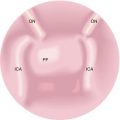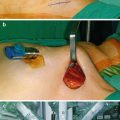Syndrome
Gene (chromosome)a,b
Clinical manifestations
% With PHEO
% Bilateral
von Hippel-Lindauc
VHL (3p25-p26)
PHEO, cerebellar hemangioblastoma, retinal angiomas, renal cell carcinoma, pancreatic cysts, pancreatic NETs in 5–10 %
10–20 %
40–80
Multiple endocrine neoplasia type 2Ad
RET (10q11.2)
PHEO, MTC, hyperparathyroidism
50 %
50–80
Multiple endocrine neoplasia type 2B
PHEO, MTC, mucosal neuromas, colonic ganglioneuromatosis, marfanoid facies, skeletal abnormalities
von Recklinghausen’s disease
NF1 (17q11.2)
Neurofibromata, >6 café au lait spots, axillary freckling, skeletal abnormalities, and PHEO
5–10 %
10
PGL-1
SDHD (11q23)
Parasympathetic head and neck PGL +/− PHEO
Uncommon
–
PGL-2
SDHAF2 (11q13.1)
Parasympathetic head and neck PGL (nonfunctioning)
Not described
–
PGL-3
SDHC (1q21)
Parasympathetic head and neck PGL, PHEO rare
Rare
–
PGL-4
SDHB (1p35-p36)
Sympathetic abdominal PGL and PHEO – 50 % malignant
PGL or PHEO in 70 %
Familial pheochromocytoma
TMEM127 (2q11)
PHEO
?
43
Familial neural crest-derived tumors
KIF1B (1p36.2)
PHEO or neuroblastoma
?
?
PHEO/PGL of genetic origin is more likely to be bilateral, extra-adrenal, multifocal and associated with an increased risk of malignancy.
Macroscopically, PHEO and PGL are soft vascular tumors with a pink-tan color on slicing. Microscopically, they exhibit a regular nested “Zellballen” pattern of polyhedral cells that are chromaffin positive on staining.
The definitive markers for malignancy are local invasion and distant metastasis. However size >5 cm, presence of lymphovascular or capsular invasion, and increased Ki-67 proliferation index are associated with increased risk.
Presentation
May be symptomatic or asymptomatic.
Symptomatic tumors present with typical triad of paroxysmal headache (90 %), sweating (92 %), and palpitations (72 %).
0.2 % of patients investigated for hypertension will have a PHEO, and 70 % of those with PHEO will have sustained hypertension.
About 10 % of PHEO are discovered incidentally on CT/MRI for unrelated symptoms (adrenal “incidentaloma”).
Asymptomatic tumors may be diagnosed during screening for genetic disorders in which PHEO or PGL is part of the disease phenotype (in order of commonality, VHL, MEN2A or B, NF1, SDHB/C/D).
Clinical signs are usually absent.
Investigations (See Chap. 1)
The diagnosis is biochemical.
Measure plasma or urinary metanephrines.
Metanephrine and/or catecholamine values that are 4 times greater than upper limit of normal are 100 % diagnostic for functioning PHEO and PGL.
Sympathomimetics and other drugs should be stopped prior to testing.
Positive biochemical testing should be followed by cross-sectional adrenal imaging since this is the most common location.
Stay updated, free articles. Join our Telegram channel

Full access? Get Clinical Tree





